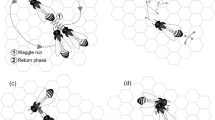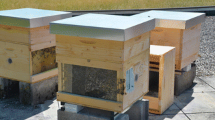Summary
The proportion of a honeybee colony's foragers which locate forage patches by independent scouting, as opposed to following recruitment dances, varies between about 5 and 35%, depending on forage availability. Experienced foragers scout more than do novice foragers. The cost of finding a forage patch is greater for recruits than scouts, but the patches found by recruits are evidently superior to those found by scouts. The honeybee's combined system of recruitment communication, scout-recruit division of labor, and selectivity in recruitment, apparently enhances a colony's overall foraging efficiency by guiding a large majority of a colony's foragers to good forage patches.
Similar content being viewed by others
References
Bayer RD (1982) How important are bird colonies as information centers? Auk 99:31–40
Boch R (1956) Die Tänze der Bienen bei nahen und fernen Trachtquellen. Z Vergl Physiol 38:136–167
Butler CG (1945) The influence of various physical and biological factors of theenvironment on honeybee activity and nectar concentration and abundance. J Exp Biol 20:65–73
Esch HA, Bastian JA (1970) How do newly recruited honey bees approach a food site? Z Vergl Physiol 68:175–181
Fisher J (1954) Evolution and bird sociality. In: Huxley JS, Hardy AC, Ford EB (ed) Evolution as a process. Alten and Unwin, London, pp 71–83
Frisch K von (1923) Über die “Sprache” der Bienen, eine tierpsychologische Untersuchung. Zool Jahrb Abt Allg Zool Physiol Tiere 40:1–186
Frisch K von (1967) The dance language and orientation of bees. Harvard University Press, Cambridge (Massachusetts)
Fukuda H, Moriga K, Sekiguchi K (1969) The weight of crop contents in foraging honeybee workers. Ann Zool Jpn 42:80–90
Gould JL (1976) The dance-language controversy. Q Rev Biol 51:211–244
Heinrich B (1976) Bumblebee foraging and the economics of sociality. Am Sci 64:384–395
Heinrich B (1979) Bumblebee economics. Harvard University Press, Cambridge (Massachusetts)
Heinrich B (1980) Mechanisms of body-temperature regulation in honeybees, Apis mellifera. II. Regulation of thoracic temperature at high air temperatures. J Exp Biol 85:73–87
Kammer AE, Heinrich B (1978) Insect flight metabolism. Adv Insect Physiol 13:133–228
Kleiber M (1961) The fire of life: an introduction to animal energetics. Wiley, New York
Krebs JR (1974) Colonial nesting and social feeding as strategies for exploiting food resources in the great blue heron (Ardea herodias). Behaviour 51:99–134
Lindauer M (1952) Ein Beitrag zur Frage der Arbeitsteilung im Bienenstaat. Z Vergl Physiol 34:299–345
Lindauer M (1954) Temperaturregulierung und Wasserhaushalt im Bienenstaat. Z Vergl Physiol 36:391–432
Mautz D (1971) Der Kommunikationseffekt der Schwänzeltänze bei Apis mellifica carnica (Pollm.). Z Vergl Physiol 172:197–220
Meyer WH, Plusnin BA (1945) The Yale Forest in Tolland and Windham Counties, Connecticut. Yale Univ School For Bull 55:1–126
Michener CD (1974) The social behavior of the bees. A comparative study. Harvard University Press, Cambridge (Massachusetts)
Oettingen-Spielberg T zu (1949) Über das Wesen der Suchbiene. Z Vergl Physiol 31:454–489
Oster GF, Wilson EO (1978) Caste and ecology in the social insects. Princeton University Press, Princeton (New Jersey)
Otis GW (1982) Weights of worker honeybees in swarms. J Apic Res 21:88–92
Seeley TD (1977) Measurement of nest cavity volume by the honey bee (Apis mellifera). Behav Ecol Sociobiol 2:201–227
Seeley TD, Seeley RH, Akratanakul P (1982) Colony defense strategies of the honeybees in Thailand. Ecol Monogr 52:43–63
Sokal RR, Rohlf FJ (1969) Biometry. Freeman, San Francisco
Southwick EE, Loper GM, Sadwick SE (1981) Nectar production, composition, energetics and pollinator attractiveness in spring flowers of western New York. Am J Bot 68:994–1002
Visscher PK, Seeley TD (1982) Foraging strategy of honeybee colonies in a temperate deciduous forest. Ecology 63:1790–1801
Ward P (1965) Feeding ecology of the black-faced dioch Quelea quelea in Nigeria. Ibis 107:173–214
Ward P, Zahavi A (1973) The importance of certain assemblages of birds as “information-centres” for food-finding. Ibis 115:517–534
Zahavi A (1971) The function of pre-roost gatherings and communal roosts. Ibis 113:106–109
Author information
Authors and Affiliations
Rights and permissions
About this article
Cite this article
Seeley, T.D. Division of labor between scouts and recruits in honeybee foraging. Behav Ecol Sociobiol 12, 253–259 (1983). https://doi.org/10.1007/BF00290778
Received:
Accepted:
Issue Date:
DOI: https://doi.org/10.1007/BF00290778




